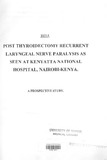| dc.contributor.author | Wahome, James N | |
| dc.date.accessioned | 2012-11-13T12:42:57Z | |
| dc.date.available | 2012-11-13T12:42:57Z | |
| dc.date.issued | 2007 | |
| dc.identifier.uri | http://erepository.uonbi.ac.ke:8080/handle/123456789/6370 | |
| dc.description | (data migrated from the old repository) | |
| dc.description.abstract | Background:
Iatrogenic injury of recurrent laryngeal nerve (RLN) is one of the most serious concerns in thyroid surgery. I carried out a prospective study aimed at determining the prevalence of RLN paralysis, its presentation and the associated risk factors among patients undergoing thyroidectomy at Kenyatta National hospital (KNH), Nairobi, Kenya.
Methods:
All patients had indirect laryngoscopy (lL) done one day before operation
to assess the integrity of the RLNs through vocal cords function. Patients with RLN paralysis prior to surgery were excluded from the study. Symptoms occurring one day after surgery were noted down. This was repeated at around six weeks post-operation and patients presenting with symptoms suggestive of RLN paralysis had a second IL done. Correlation between the occurrence of paralysis and the age, sex, histopathological process, type of operation done, surgeon's experience and intra-operative RLN identification was done.
Results:
Seventy-one (88.8%) had benign thyroid disease while 9 (11.2%) had cancer
of thyroid. Seven patients (8.8%) were found to have developed RLN paralysis with the majority (57.1 %) having suffered left adductor paralysis. Re-operation for recurrent malignancy had the highest rate of paralysis (40%) while primary operations in general (5.6%) and primary operations for benign disease (5.9%) had the lowest rates. Three patients (42.9%) presented with hoarseness alone, 3 (42.9%) with hoarseness and aspiration while 1 (14.2%) had dyspnoea.
Conclusions:
Thyroidectomy is an important etiological factor to developing RLN paralysis at KNH. Re-operations on the thyroid and failure to identify the RLN intra-operatively are significant risk factors to developing RLN paralysis. The majority of patients who develop RLN paralysis following thyroidectomy at KNH present with hoarseness. | en_US |
| dc.language.iso | en | en_US |
| dc.publisher | University of Nairobi, CHS, Kenya | en_US |
| dc.subject | Thyroid gland -- surgery | en_US |
| dc.subject | Thyroidectomy | en_US |
| dc.subject | Postoperative period | en_US |
| dc.subject | Surgery -- Complications and sequelae | en_US |
| dc.subject | Larynx -- Diseases | en_US |
| dc.title | Post thyroidectomy recurrent laryngeal nerve paralysis as seen at Kenyatta National Hospital, Nairobi-Kenya | en_US |
| dc.title.alternative | Thesis (M.Med.) | en_US |
| dc.type | Thesis | en_US |

